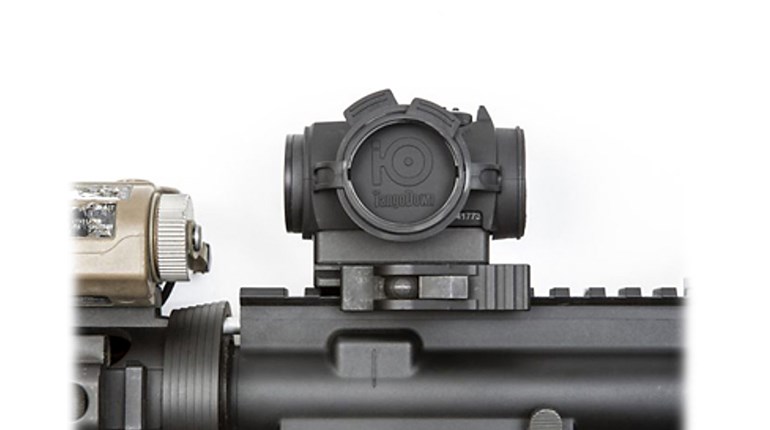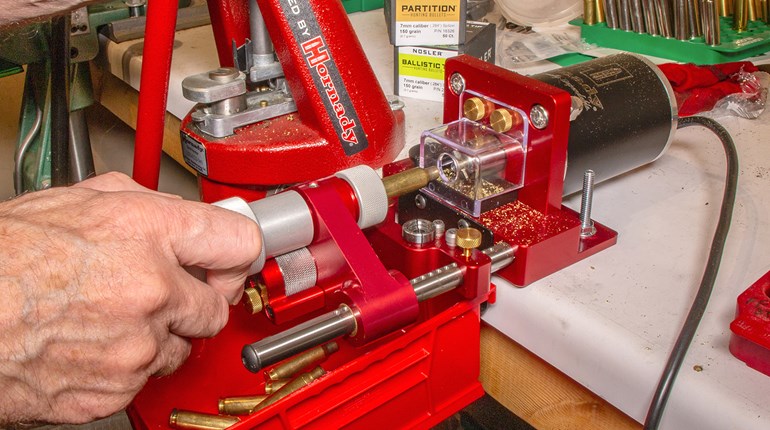
All red-dot sights are not created equal. In fact, many supposed red-dot sights are not really red-dot sights at all. Well, they kinda are, but… The term “red-dot sight” has been around for a long time and is used, generically, to describe nonmagnifying sights that use an illuminated red dot as an aiming point. It’s kind of like ordering a soda in the South: you ask for a Coke, no matter what’s on the menu. Of course, the other reason is, regardless of the way the sight works, you will be using a red dot to aim. Where it gets confusing is in the way that red (now sometimes green or another color) dot is generated.

For our purposes, let’s erase the term “red dot” from our vocabulary as a means of describing sights and use it only to describe the aiming point. In order to simplify the subject, let’s split the sights that utilize a nonmagnifying, illuminated dot into three categories: prismatic, reflex and holographic. We can further simplify the topic by understanding a variety of companies make prismatic and reflex sights, but only one company manufactures holographic sights.
A prismatic sight is similar to a riflescope, but has fewer lenses. What it does have is a prism to flip the image, so it doesn’t appear upside down. In a prismatic sight, the reticle is etched on glass, so it can be in any shape or configuration and can also be illuminated. Unlike reflex and holographic sights, which have no eye-relief constraints, a prismatic sight will have a set eye relief.
With a reflex sight, the aiming point (or dot) is an LED (light-emitting diode) projected forward onto a lens (some Trijicon and Meprolight reflex sights use tritium instead of electronics to achieve illumination). The lens is kind of like a mirror, and because of that, when looking through the sight, the image is slightly darker. Basically, there are two types of reflex sights: One is very compact and the beam is exposed. The other type is tube shaped, looks like an abbreviated riflescope and its beam is contained.
As for the holographic sight, EOTech is the only company manufacturing them: it controls the patent (Bushnell’s Holosights were made by EOTech). A holographic sight has a photograph of a reticle sandwiched between layers of glass. The reticle is illuminated by a laser and can take any shape. Further, it can also contain additional aiming points.
 The differences between these sights are not just cosmetic or mechanical. Each type of sight brings something different to the table, and you should choose your sight based on the way you will use the firearm on which it is to be installed. There are simply too many sights like these to compare them all, but let’s examine examples of each style and compare them head-to-head to establish the pros and cons of each option.
The differences between these sights are not just cosmetic or mechanical. Each type of sight brings something different to the table, and you should choose your sight based on the way you will use the firearm on which it is to be installed. There are simply too many sights like these to compare them all, but let’s examine examples of each style and compare them head-to-head to establish the pros and cons of each option.
I selected a high-end example of each of the four sight systems and alternately mounted them on a Daniel Defense M4V7 carbine. The prismatic sight was represented by Leupold’s aptly named Prismatic Sight. An Aimpoint Patrol Rifle Optic (PRO) was used as the tubular, reflex-style sight and a Trijicon fiber-optic and tritium-illuminated RMR as the open type of reflex sight. The .300 AAC Blackout version of EOTech’s model XPS2 represented the holographic sights.
Running the carbine through my Scout Rifle Workout drill, where the shooter is required to hit a 5-inch circle at 50 yards from the standing, kneeling, sitting and prone positions in less than 30 seconds, I could really see no difference between the sights. My times and hits were nearly identical, regardless of the sight used. However, the height of the sight above the rail was noticeable. I was able to obtain a better stock-to-cheek weld to the exposed reflex sight—the Trijicon RMR—due to its compactness. This sight and others like it can be mounted very low.
Of course, this brings up co-witnessing the backup iron sights. Such was possible with the Leupold Prismatic, Aimpoint PRO and EOTech holographic, but the Trijicon RMR was mounted so low, co-witnessing the iron sights was not possible.
To obtain the optical co-witnessing alignment, it’s best if the center of the optical sight is at the same height above the receiver as the open sights. This height is typically about 1.5 inches above the rail.
Along the same lines, size and weight are important considerations. RMR-type sights are very light, tipping the scales at about 2 ounces or less, and measure only about 2 inches long and an inch high. RMR-style reflex sights are, on average, about a quarter the weight and a third the size of prismatic, tubular reflex and holographic sights. For this reason, some shooters, like Shooting Illustrated Field Editor Bryce M. Towsley, use a sight like this as a backup to a traditional rifle scope by mounting them coaxially, but at a 45-degree angle to the scope.
The use of a separate magnifier is also common with the application of nonmagnifying sights. A unit like the EOTech G33 provides 3X magnification, which can be handy when trying to make a precision shot at extended range. A prismatic-style sight will not work with a magnifier, but any reflex or holographic sight should. However, there’s more to the story.
Due to the mechanics of a reflex sight, a 3-MOA red dot is about as small of an aiming point that can be achieved. With the holographic sight, aiming points can be as small as 1 MOA. While the two may appear the same size when viewed at the same intensity level without the magnifier, through the magnifier the 1-MOA holographic sight aiming point will appear just about 1 MOA in size. Amazingly, the magnifier does not magnify the dot. This could be important if longer-range precision shots are in order. It’s worth noting since the tritium/fiber-optic powered Trijicon RMR can have a triangular aiming point, the tip of the triangle can provide a precision aiming point with or without a magnifier.
It’s also important to note both the holographic sight and the prismatic sight utilize a reticle as opposed to the simple reflection of light source. This means for these sights, reticles with multi-aiming points and various shapes can be created. For example, the EOTech 300 Blackout holographic sight has a two-aiming-point reticle designed for supersonic and subsonic .300 AAC Blackout cartridges. And, just as importantly, when this sight is combined with a magnifier, the subtension between these points does not change.
 The holographic sight has another distinct advantage, and that’s field-of-view. All of these nonmagnifying sights are intended to be used with both eyes open—after all, part of the concept and benefit of using a nonmagnifying sight is the ability to keep your eyes open. EOTech’s holographic sights have a huge viewing window and are also parallax free, no matter what area of the window you’re aiming through. Other nonmagnifying sights are very near parallax free when the eye is perfectly centered behind them, but not to the extent of the holographic sight during off-axis viewing.
The holographic sight has another distinct advantage, and that’s field-of-view. All of these nonmagnifying sights are intended to be used with both eyes open—after all, part of the concept and benefit of using a nonmagnifying sight is the ability to keep your eyes open. EOTech’s holographic sights have a huge viewing window and are also parallax free, no matter what area of the window you’re aiming through. Other nonmagnifying sights are very near parallax free when the eye is perfectly centered behind them, but not to the extent of the holographic sight during off-axis viewing.
All of these sights operate on battery power, apart from the tritium/fiber-optic powered RMR. Battery life is a very important consideration. Run times vary between 25 days and four years of continuous use. The holographic sight, which uses a laser as opposed to an LED, has the shortest run time, while the tritium/fiber-optic RMR will become half as bright after a decade or so as the tritium in the reticle decays. Aimpoint’s battery-powered PRO has a run time of 30,000 hours, so you need only change the batteries about once every three years, even if you leave the sight on 24/7. Some of the company’s other sights have a battery life in excess of 50,000 hours.
As for durability, I didn’t try to break any of these sights, but I did not treat them like tender flowers, either. I experienced no failures of any kind, but it is worth noting, with every sight apart from the RMR, I had to make occasional illumination-intensity adjustments depending on the ambient light and the target.
Water resistance and performance in rugged/dirty conditions also play a role in your decision. Anytime you’re dealing with glass lenses, you’ll experience problems with dust, debris and moisture. For optimal performance, keep your lenses clean. (Interestingly, you can cover the front of the lens of a holographic sight—and most reflex sights—and place the aiming point on target if you keep both eyes open. This is a benefit of our binocular vision.) However, with the exposed reflex sight, like the RMR, if dirt or water gets on top of the housing from where the illumination projection is transmitted, which is exposed to the elements, your aiming point will disappear—a critical point to consider if backup sights are not going to be available.
And finally, one element of any gear acquisition is always price. The sights discussed here are high-end examples, and their prices reflect that. This brings us to less-expensive options. Various companies like Weaver and even Cabela’s offer prismatic sights that retail for half or less than the Leupold. Tubular enclosed reflex sights are available for as little as $25 from BSA, $70 from Barska, $130 from TruGlo, $170 from Vortex and the list goes on. As for exposed compact reflex sights, you can pick up one from Sightmark for less than $100, while Bushnell and Cabela’s have them for around $125. As you might expect, this variation in pricing also reflects quality and the sourcing of offshore parts and labor. The sights used for comparison in this article were all built to Mil-Spec standards; be aware, others might not be.
You won’t find this price variation with holographic sights. EOTech is the only holographic sight manufacturer and holographic technology is very involved and expensive. You might see offshore companies claiming their sights to be holographic sights, and they might even look like EOTech sights, but in truth, they are just more reflex-type sights.
Which sight is right? As with most anything it depends, and there is a lot to consider. There’s no single answer because your needs and credit-card limit should dictate the decision more than the opinion of the sales guy at the gun shop. Just remember, there is no such thing as “just a red-dot sight.” Understand the differences and equip yourself accordingly.






































